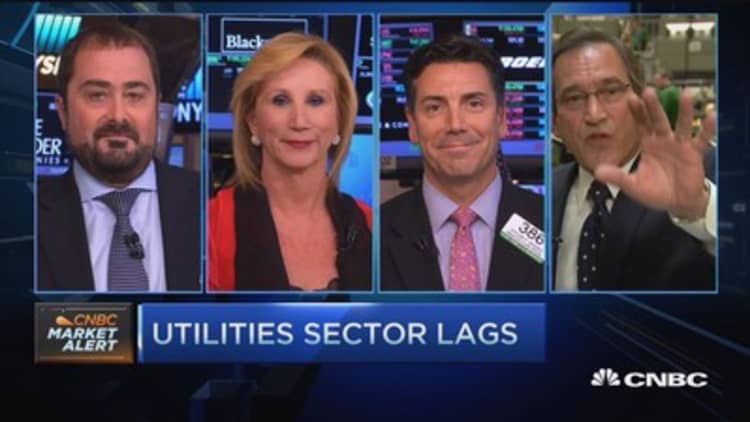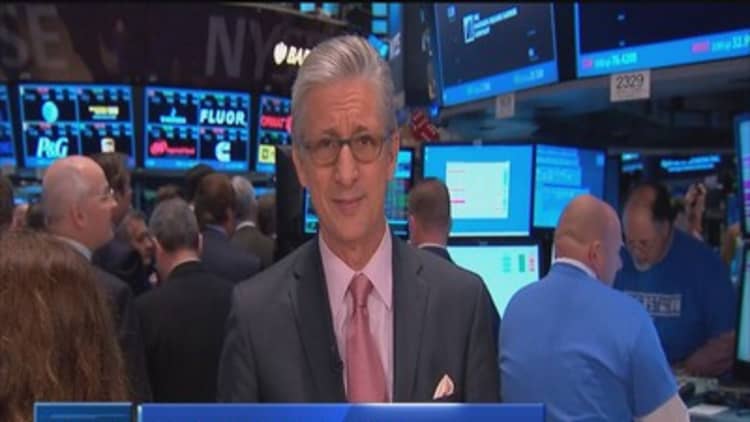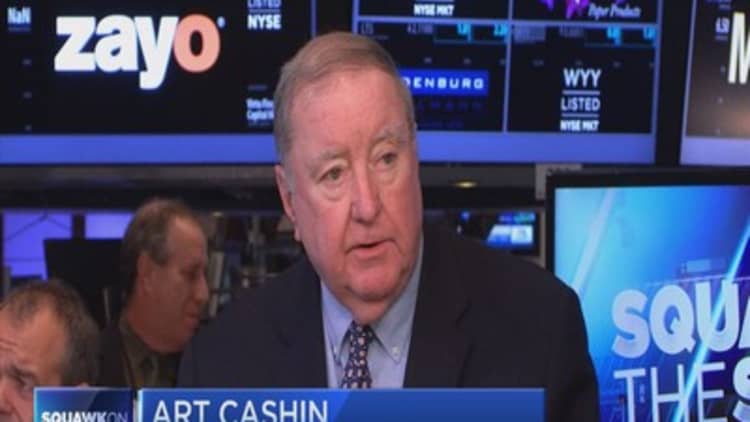




U.S. stocks closed narrowly mixed Thursday, attempting to put a steady start to the fourth quarter, as investors weighed soft manufacturing data and looked ahead to Friday's jobs report. (Tweet This)
"I think we had a big rally yesterday, (and) the revival Tuesday to the upside, so we're still digesting that," said Bruce Bittles, chief investment strategist at RW Baird. "The primary trend is still down."
The S&P 500 and Nasdaq composite eked out mild gains in the close, recovering intraday declines of more than 1 percent.
The major averages opened higher before quickly falling into negative territory, with the Dow Jones industrial average closing down about 13 points after falling as much as 211 points. In the close, IBM was the greatest weight on the blue chip index.
Major averages Thursday performance
The Dow transports closed 0.6 percent higher, with Kansas City Southern leading most constituents higher.
"Transports held pretty good for much of the day ... a good indication the market is not fearful of the economy weakening further," said Peter Cardillo, chief market economist at Rockwell Global Capital. "The 10-year (yield) flirting with 2 percent, never dipped below there. (There's) no panic."
He also noted some short covering ahead of Friday's jobs report.
Read More'Incredibly fearful' Fed braces for jobs report
Materials gained 1 percent to lead the S&P higher. Earlier, the index failed to hold gains as energy turned lower, following crude and brent in giving up sharp morning gains. Crude settled down 35 cents at $44.74 a barrel. Utilities and telecommunications were the greatest laggards.
Apple closed off session lows, down 0.65 percent, after briefly falling 2.7 percent. The iShares Nasdaq Biotechnology ETF (IBB) closed up 0.75 percent, more than recovering a 2 percent intraday decline.
The major averages turned lower after a positive open on the back of slight gains in the futures market.
"We're just continuing the pattern of selling into rallies," said Peter Boockvar, chief market analyst at The Lindsey Group. ISM "is a wake up call that the U.S. economy is very bifurcated. Also, (the stock market is) jockeying ahead of payrolls tomorrow."
The monthly nonfarm payrolls report is due Friday at 8:30 a.m., ET.
The key economic report out Thursday, the , fell to the lowest level since May 2013 at 50.2, a decline from August's 51.1 print.
Guy LeBas, chief fixed income strategist at Janney Montgomery Scott, expected a read of 50.1. "Most of the manufacturing indices have had a rough summer period and the ISM is no different," he said. It shows "how negative low energy prices have been for the manufacturing sector."
"It seems the benefit of low energy prices to the consumer is being dwarfed by impact to the industry," LeBas said.
Stocks dipped following the release of the report.
The ISM manufacturing data is "indicative of the sector moving towards contraction at this point," Cardillo said. "The ISM was certainly very disappointing and taking stocks out of the surge,"
"I think the market is probably going to stay on the jittery side, looking ahead to jobs," he said. "We'll probably just linger around these levels until we get earnings season out of the way."
Other economic reports out Thursday continued to show strength in the housing and auto sectors.
August construction spending rose to its highest level since 2008, driven by residential projects.
September auto sales came in at an 18.17 million, the highest run rate since July 2005, Autodata said. General Motors, Ford Motor, and the U.S. operations of Fiat Chrysler Automobiles reported a jump in September sales as cheap gasoline and ultra-low interest rates drove demand for sport utility vehicles and pickup trucks.
"Pretty much everything involving the consumer is positive," said Doug Cote, chief market strategist at Voya Investment Management.
Initial jobless claims showed a slight increase to 277,000. The September U.S. Markit manufacturing PMI came in at 53.1.
The number of announced layoffs by U.S.-based companies surged 43 percent in September from the previous month, driven by job cuts at Hewlett-Packard, global outplacement firm Challenger, Gray & Christmas reported Thursday.
The U.S. dollar traded mildly lower against major world currencies, with the euro below $1.12 and the yen at 119.94 yen against the greenback.
Treasury yields edged higher, with the 10-year yield at 2.04 percent, after hitting 2.00 for the first time since Aug. 24. The traded near 0.64 percent.
San Francisco Federal Reserve Bank President John Williams on Thursday renewed, in prepared remarks, his call for an interest-rate hike "sometime later this year," citing near-full employment and rapidly rising house prices that may be a sign of excessive economic optimism, Reuters reported.
Richmond Fed President Jeffrey Lacker said in an interview with The Wall Street Journal that an October rate rise is still possible and that strong consumer spending shows a rate rise is needed, Dow Jones reported.
Both Williams and Lacker are voting members of the Federal Reserve.
Stocks rallied about 1.5 percent or more Wednesday but were still about 7 percent lower for the third quarter, their worst in four years.
"We were very, very oversold on a short-term basis," said Lance Roberts, head of Streettalklive.com. "It very much looked like institutions coming in to fill orders than sustained buying."
"We're still oversold. I do think (we get) a rally in the next few days," he said. Longer-term, "we are building a very defined downtrend at the moment. We're creating this downward trend in prices, more inclined to decline."
Read MoreWhat's next for stocks after worst quarter in four years
The CBOE Volatility Index (.VIX), widely considered the best gauge of fear in the market, traded below 23.
Randy Frederick, director of trading and derivatives at Charles Schwab, doesn't think the VIX will fall below 20 until after the Federal Reserve's meeting Oct. 27 to 28.
"The VIX is reflecting we still have questionable economic data from around the world. We don't know if the government is going to keep operating through the end of the year," he said. "There are a whole lot of things culminating in Q4 that are keeping anxiety high."
Congress approved legislation Wednesday that keeps the federal government in operation until Dec. 11.
Major U.S. Indexes
In Europe, the German DAX fell 1.57 percent and the pan-European Stoxx 600 index closed 0.4 percent lower despite rallies in Asia and Wall Street overnight. In Asia, Japan's Nikkei finished 1.92 percent higher. Volkswagen and Glencore both ended mildly lower.
Chinese stock markets in both the mainland and Hong Kong were closed for the National Day Holiday. On Wednesday, the Shanghai Composite index closed up 0.50 percent.
No major earnings reports were expected Thursday.
Read MoreEarly movers: MKC, CAG, GPS, GOOGL, MSFT, WMT, NOC & more
The Dow Jones Industrial Average closed down 12.69 points, or 0.08 percent, at 16,272.01, with Caterpillar leading decliners and Pfizer the greatest advancer.
The closed up 3.79 points, or 0.20 percent, at 1,923.82, with utilities leading five sectors lower and materials the greatest advancer.
The Nasdaq closed up 6.92 points, or 0.15 percent, at 4,627.08.
Decliners were a touch ahead of advancers on the New York Stock Exchange, with an exchange volume of 979 million and a composite volume of nearly 4.0 billion in the close.
Gold futures settled down $1.50 at $1,113.70 an ounce.
On tap this week:
Friday
8:30 a.m.: Employment; Boston Fed President Eric Rosengren at Boston Fed conference
9 a.m.: Minneapolis Fed President Narayan Kocherlakota
10 a.m.: Factory orders
11 a.m.: Cleveland Fed President Loretta Mester
1:30 p.m.: Fed Vice Chair Stanley Fischer on monetary policy at Boston Fed
More From CNBC.com:


